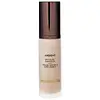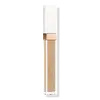Hourglass Cosmetics Ambient Soft Glow Foundation Versus Flower Beauty by Drew Light Illusion Full Coverage Concealer
What's inside
What's inside
 Key Ingredients
Key Ingredients

 Benefits
Benefits

 Concerns
Concerns

 Ingredients Side-by-side
Ingredients Side-by-side

Water
Skin ConditioningCyclopentasiloxane
EmollientCyclohexasiloxane
EmollientIsododecane
EmollientTrimethylsiloxysilicate
EmollientGlycerin
HumectantButylene Glycol
HumectantDimethicone
EmollientLauryl PEG-10 Tris(Trimethylsiloxy)Silylethyl Dimethicone
EmulsifyingPolymethylsilsesquioxane
1,2-Hexanediol
Skin ConditioningDisteardimonium Hectorite
StabilisingAcrylates/Polytrimethylsiloxymethacrylate Copolymer
Skin ConditioningMagnesium Sulfate
Sorbitan Sesquioleate
EmulsifyingDimethicone/Vinyl Dimethicone Crosspolymer
Skin ConditioningTriethoxycaprylylsilane
Dimethicone/PEG-10/15 Crosspolymer
Aluminum Hydroxide
EmollientTribehenin
EmollientCaprylyl Glycol
EmollientTocopheryl Acetate
AntioxidantEthylhexylglycerin
Skin ConditioningXanthan Gum
EmulsifyingCaesalpinia Spinosa Fruit Extract
Skin ProtectingDipropylene Glycol
HumectantSodium Citrate
BufferingKappaphycus Alvarezii Extract
Skin ConditioningTocopherol
AntioxidantCamellia Sinensis Leaf Extract
AntimicrobialCI 77891
Cosmetic ColorantIron Oxides
Water, Cyclopentasiloxane, Cyclohexasiloxane, Isododecane, Trimethylsiloxysilicate, Glycerin, Butylene Glycol, Dimethicone, Lauryl PEG-10 Tris(Trimethylsiloxy)Silylethyl Dimethicone, Polymethylsilsesquioxane, 1,2-Hexanediol, Disteardimonium Hectorite, Acrylates/Polytrimethylsiloxymethacrylate Copolymer, Magnesium Sulfate, Sorbitan Sesquioleate, Dimethicone/Vinyl Dimethicone Crosspolymer, Triethoxycaprylylsilane, Dimethicone/PEG-10/15 Crosspolymer, Aluminum Hydroxide, Tribehenin, Caprylyl Glycol, Tocopheryl Acetate, Ethylhexylglycerin, Xanthan Gum, Caesalpinia Spinosa Fruit Extract, Dipropylene Glycol, Sodium Citrate, Kappaphycus Alvarezii Extract, Tocopherol, Camellia Sinensis Leaf Extract, CI 77891, Iron Oxides
Water
Skin ConditioningDimethicone
EmollientTrimethylsiloxysilicate
EmollientCaprylyl Methicone
Skin ConditioningIsoamyl Laurate
EmollientIsododecane
EmollientButylene Glycol
HumectantGlycerin
HumectantMica
Cosmetic ColorantEthylhexyl Palmitate
EmollientHdi/Trimethylol Hexyllactone Crosspolymer
Silica
AbrasivePEG/PPG-18/18 Dimethicone
EmulsifyingPEG-10 Dimethicone
Skin ConditioningHydrogenated Lecithin
EmulsifyingC10-18 Triglycerides
EmollientSodium Chloride
MaskingQuaternium-90 Bentonite
Aroma
Jojoba Esters
EmollientCaprylyl Glycol
EmollientHelianthus Annuus Seed Wax
Skin ConditioningPhenoxyethanol
PreservativeDimethicone/Vinyl Dimethicone Crosspolymer
Skin ConditioningPotassium Sorbate
PreservativeSodium Dehydroacetate
PreservativePropylene Carbonate
SolventSodium Gluconate
Skin ConditioningHexylene Glycol
EmulsifyingAcacia Decurrens Flower Wax
EmollientPolyglycerin-3
HumectantQuartz
AbrasiveTitanium Dioxide
Cosmetic ColorantIron Oxides
Water, Dimethicone, Trimethylsiloxysilicate, Caprylyl Methicone, Isoamyl Laurate, Isododecane, Butylene Glycol, Glycerin, Mica, Ethylhexyl Palmitate, Hdi/Trimethylol Hexyllactone Crosspolymer, Silica, PEG/PPG-18/18 Dimethicone, PEG-10 Dimethicone, Hydrogenated Lecithin, C10-18 Triglycerides, Sodium Chloride, Quaternium-90 Bentonite, Aroma, Jojoba Esters, Caprylyl Glycol, Helianthus Annuus Seed Wax, Phenoxyethanol, Dimethicone/Vinyl Dimethicone Crosspolymer, Potassium Sorbate, Sodium Dehydroacetate, Propylene Carbonate, Sodium Gluconate, Hexylene Glycol, Acacia Decurrens Flower Wax, Polyglycerin-3, Quartz, Titanium Dioxide, Iron Oxides
 Reviews
Reviews

Ingredients Explained
These ingredients are found in both products.
Ingredients higher up in an ingredient list are typically present in a larger amount.
Butylene Glycol (or BG) is used within cosmetic products for a few different reasons:
Overall, Butylene Glycol is a safe and well-rounded ingredient that works well with other ingredients.
Though this ingredient works well with most skin types, some people with sensitive skin may experience a reaction such as allergic rashes, closed comedones, or itchiness.
Learn more about Butylene GlycolCaprylyl Glycol is a humectant and emollient, meaning it attracts and preserves moisture.
It is a common ingredient in many products, especially those designed to hydrate skin. The primary benefits are retaining moisture, skin softening, and promoting a healthy skin barrier.
Though Caprylyl Glycol is an alcohol derived from fatty acids, it is not the kind that can dry out skin.
This ingredient is also used as a preservative to extend the life of products. It has slight antimicrobial properties.
Learn more about Caprylyl GlycolDimethicone is a type of synthetic silicone created from natural materials such as quartz.
What it does:
Dimethicone comes in different viscosities:
Depending on the viscosity, dimethicone has different properties.
Ingredients lists don't always show which type is used, so we recommend reaching out to the brand if you have questions about the viscosity.
This ingredient is unlikely to cause irritation because it does not get absorbed into skin. However, people with silicone allergies should be careful about using this ingredient.
Note: Dimethicone may contribute to pilling. This is because it is not oil or water soluble, so pilling may occur when layered with products. When mixed with heavy oils in a formula, the outcome is also quite greasy.
Learn more about DimethiconeThis ingredient is a silicone used to improve the texture of products and absorb oil. It does not get absorbed into the skin.
Like other silicones, Dimethicone/Vinyl Dimethicone Crosspolymer helps condition the skin by creating a barrier. In this sense, it can act as an emollient and trap moisture in.
This ingredient is a type of elastomer.
Learn more about Dimethicone/Vinyl Dimethicone CrosspolymerGlycerin is already naturally found in your skin. It helps moisturize and protect your skin.
A study from 2016 found glycerin to be more effective as a humectant than AHAs and hyaluronic acid.
As a humectant, it helps the skin stay hydrated by pulling moisture to your skin. The low molecular weight of glycerin allows it to pull moisture into the deeper layers of your skin.
Hydrated skin improves your skin barrier; Your skin barrier helps protect against irritants and bacteria.
Glycerin has also been found to have antimicrobial and antiviral properties. Due to these properties, glycerin is often used in wound and burn treatments.
In cosmetics, glycerin is usually derived from plants such as soybean or palm. However, it can also be sourced from animals, such as tallow or animal fat.
This ingredient is organic, colorless, odorless, and non-toxic.
Glycerin is the name for this ingredient in American English. British English uses Glycerol/Glycerine.
Learn more about GlycerinIsododecane is a fragrance, emollient, and solvent.
As an emollient, it helps your skin stay soft and hydrated. Emollients help trap moisture into your skin.
Isododecane's role as a solvent makes it a great texture enhancer. It spreads smoothly on skin and does not leave a sticky feeling behind. Isododecane also helps prevent color transfer in makeup products.
Isododecane is not absorbed into skin.
Learn more about IsododecaneThis silicone is an emollient. Emollients create a thin film on the skin to prevent moisture from escaping.
It is not soluble in water and helps increase water-resistance in products.
According to a manufacturer, it can blend seamlessly with silicone oils, such as Cyclopentasiloxane.
Learn more about TrimethylsiloxysilicateWater. It's the most common cosmetic ingredient of all. You'll usually see it at the top of ingredient lists, meaning that it makes up the largest part of the product.
So why is it so popular? Water most often acts as a solvent - this means that it helps dissolve other ingredients into the formulation.
You'll also recognize water as that liquid we all need to stay alive. If you see this, drink a glass of water. Stay hydrated!
Learn more about WaterThis ingredient is a combination of red, black, and yellow iron oxide pigments. This combination of colors is usually found in foundation, because it results in a "skin" color.